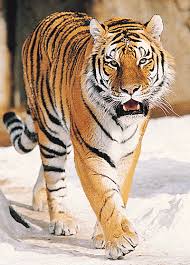Hey guys!
Have you ever thought of the food chain before? Basically, the food chain consists of many different food webs that are connected with each other. It has many levels, starting with:
Autotrophic Level: This is the producers section, the starting point of the food chain, excluding the sun. This level is mainly green plants and trees, anything that can carry out photosynthesis* and cellular respiration*.
Photosynthesis is the process in which plants absorb sunlight and use it to make food for itself.
Cellular respiration is, to put it simply, the process where plants take the energy and nutrients from the food it made and use it towards other processes.

Primary Consumer: Then we get to the primary consumers. These types of consumers are herbivorous, meaning they eat only plants. So primary consumers eat organisms from the trophic level to obtain energy.

Secondary Consumer: This type of consumer is called carnivorous, which is basically an organism that eats primary consumers or other animals to obtain energy. Carnivorous species cannot eat plants for food. For example, a tiger (secondary consumer) eats zebras (primary consumer) for energy.

Tertiary Consumer: Then we finally reach the point where humans are involved. Tertiary consumers are consumers that are omnivorous, which means we can eat both plants and other animals. An example would, of course, be humans.
(If you have a mirror, look at one, and you will see a very cool human :)
The sun is what starts and keeps this cycle going, believe it or not. Without sunlight, photosynthesis couldn't be carried out by the autotrophic level, and if that's not there, then there would be no primary consumer, and if that's not there...well, you get the picture.
That's just a brief description of the food chain, hope you guys enjoyed it!
Twitter: http://www.twitter.com/invisiproblem
My Facebook link will be above, thanks guys :)
Have you ever thought of the food chain before? Basically, the food chain consists of many different food webs that are connected with each other. It has many levels, starting with:
Autotrophic Level: This is the producers section, the starting point of the food chain, excluding the sun. This level is mainly green plants and trees, anything that can carry out photosynthesis* and cellular respiration*.
Photosynthesis is the process in which plants absorb sunlight and use it to make food for itself.
Cellular respiration is, to put it simply, the process where plants take the energy and nutrients from the food it made and use it towards other processes.
Primary Consumer: Then we get to the primary consumers. These types of consumers are herbivorous, meaning they eat only plants. So primary consumers eat organisms from the trophic level to obtain energy.
Secondary Consumer: This type of consumer is called carnivorous, which is basically an organism that eats primary consumers or other animals to obtain energy. Carnivorous species cannot eat plants for food. For example, a tiger (secondary consumer) eats zebras (primary consumer) for energy.
Tertiary Consumer: Then we finally reach the point where humans are involved. Tertiary consumers are consumers that are omnivorous, which means we can eat both plants and other animals. An example would, of course, be humans.
(If you have a mirror, look at one, and you will see a very cool human :)
The sun is what starts and keeps this cycle going, believe it or not. Without sunlight, photosynthesis couldn't be carried out by the autotrophic level, and if that's not there, then there would be no primary consumer, and if that's not there...well, you get the picture.
That's just a brief description of the food chain, hope you guys enjoyed it!
Twitter: http://www.twitter.com/invisiproblem
My Facebook link will be above, thanks guys :)